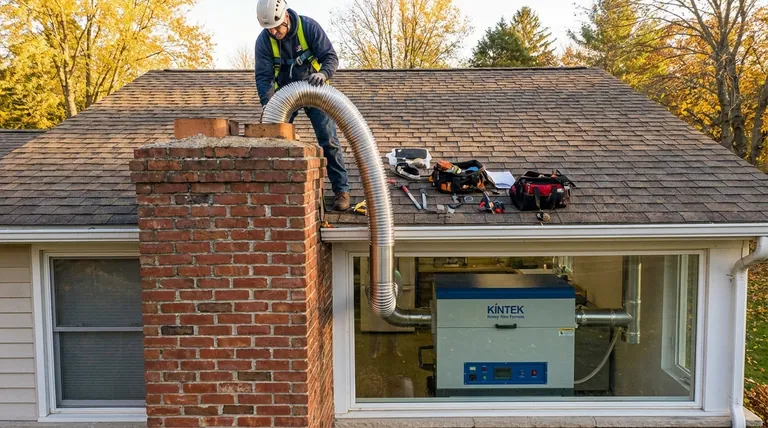In simple terms, a furnace liner is a dedicated channel, typically a metal tube, installed inside your existing chimney. Its primary job is to safely and efficiently guide the toxic exhaust gases from your furnace out of your home, protecting both your chimney structure and your family.
The core function of a furnace liner is to solve a critical mismatch between modern furnaces and older masonry chimneys. It ensures proper drafting, prevents corrosive damage to your chimney, and stops dangerous gases from leaking into your home.

The Problem: Old Chimneys and New Furnaces
To understand why a liner is so essential, you first need to understand the problem it solves. Many older homes have masonry chimneys that were built for outdated, inefficient furnaces.
The Issue of Sizing and Temperature
Older furnaces were highly inefficient, sending massive amounts of very hot air up the chimney. Chimneys were built wide to accommodate this high volume and temperature.
Modern furnaces, however, are far more efficient. They extract much more heat from the combustion process, resulting in a lower volume of much cooler exhaust gas.
The Danger of Condensation
When these cooler gases enter a wide, cold masonry chimney, they slow down and cool even further. This causes water vapor within the exhaust to condense into a liquid on the inside of the flue.
This isn't just water. The flue gases contain chemical byproducts that make the resulting condensation highly acidic and corrosive.
The Result: Chimney Deterioration
This acidic liquid eats away at the mortar joints and brickwork from the inside out. Over time, this deterioration can cause structural instability, blockages from falling debris, and dangerous leaks.
How a Furnace Liner Solves These Problems
A correctly installed furnace liner directly counteracts each of these issues, acting as a modern, correctly-sized flue within your old chimney structure.
Ensures Proper Sizing and Draft
A liner is sized specifically for your furnace. This smaller diameter keeps the exhaust gases warm and buoyant, allowing them to maintain velocity and exit the chimney effectively. This process is known as draft.
Proper draft is critical for the performance of your furnace and for ensuring all flue gases are expelled outside.
Protects Against Corrosion
The liner, often made of stainless steel or aluminum, contains the corrosive condensation. It acts as a barrier, protecting your chimney's masonry from being destroyed from within.
Enhances Safety
Deteriorating mortar joints can create pathways for exhaust gases, including deadly carbon monoxide, to leak through the chimney structure and into your home.
A continuous, sealed liner eliminates this risk, containing all gases safely within the metal tube until they are vented above your roofline.
Understanding the Trade-offs and Considerations
While essential, a liner is a significant component of your heating system, and there are key factors to consider.
Material Matters
Liners come in different materials. Aluminum is often used for mid-efficiency gas furnaces, while stainless steel is required for higher-efficiency gas units and all oil furnaces, as their exhaust is even cooler and more corrosive.
Professional Installation is Non-Negotiable
An improperly sized or installed liner is not just ineffective; it can be dangerous. It can impede draft or become disconnected, voiding its safety benefits. This is not a DIY project.
It's a Cost for Safety, Not an Upsell
If a technician recommends a liner when you install a new furnace, they are typically following building codes and manufacturer specifications. It should be viewed as a required investment in the safety and longevity of your home, not an optional add-on.
Making the Right Choice for Your System
Understanding if you need a liner depends entirely on your specific heating setup.
- If your primary focus is installing a new furnace in a home with a masonry chimney: A properly sized furnace liner is almost certainly required by code for safe and efficient operation.
- If your primary focus is maintaining an existing system but you see white stains (efflorescence) on your chimney's exterior: This is a strong sign of internal moisture damage, and a liner is likely needed to prevent further deterioration and safety risks.
- If your primary focus is a high-efficiency furnace that vents directly out a side wall with white PVC pipe: Your system does not use the chimney to vent and therefore does not need a chimney liner.
Ultimately, a furnace liner bridges the technological gap between modern heating equipment and older home construction, ensuring your system runs safely and efficiently for years to come.
Summary Table:
| Function | Benefit |
|---|---|
| Ensures Proper Draft | Maintains exhaust gas velocity for efficient furnace operation. |
| Prevents Corrosion | Contains acidic condensation, protecting masonry from damage. |
| Enhances Safety | Creates a sealed path for exhaust, preventing carbon monoxide leaks. |
Ensure your lab's heating systems are safe and efficient. Just as a proper furnace liner is critical for home safety, the right lab equipment is essential for your research integrity and productivity. KINTEK specializes in high-quality lab furnaces, ovens, and related consumables. Contact our experts today to find the perfect, safe, and reliable heating solution for your laboratory needs.
Visual Guide

Related Products
- Vacuum Sealed Continuous Working Rotary Tube Furnace Rotating Tube Furnace
- 600T Vacuum Induction Hot Press Furnace for Heat Treat and Sintering
- Graphite Vacuum Continuous Graphitization Furnace
- Small Vacuum Heat Treat and Tungsten Wire Sintering Furnace
- Lab-Scale Vacuum Induction Melting Furnace
People Also Ask
- What are the main types of biomass conversion processes? Unlock the Best Pathway for Your Energy Needs
- What is the difference between pyrolysis combustion and gasification? A Guide to Thermal Conversion Technologies
- What is the range of pyrolysis? Master Temperature Control for Optimal Bio-Product Yields
- What is the temperature of a rotary hearth furnace? Find the Right Heat for Your Process
- What is the heat required for pyrolysis? Mastering Energy Input for Optimal Biochar, Bio-Oil, or Syngas














